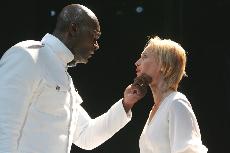
The embrace of the powerful figure of Othello and the contrastingly petite form of Desdemona was center stage as the lights opened to “Othello,” Cincinnati Playhouse in the Park’s newest production. As one of the Bard’s more relevant plays in our time and social climate, it is the popular tale of Iago, one of literature’s most clever and charismatic villains, and his carefully orchestrated destruction of all that the outsider Othello holds dear.
The play, which is being performed in the intimately enclosed space of the playhouse’s Shelterhouse Theatre, holds its greatest strengths in the stark and minimalist imagery and lighting used on stage.
It is very different from what patrons may expect from a Shakespeare production; the opening scene contains nothing more than a mattress with sheets on a carpeted stage.
Extremely effective use of the contrasting colors of black and white abound, with the white tile of Cyprus standing bold against the black furniture. I often found myself more entranced by the stage elements and precise use of lighting that highlighted (or obscured) the action more than the action itself.
My major complaint of the set’s design, however, lies in the fact that the stage juts into the audience and is surrounded on three sides by seats. It wasn’t until I read later in the playbill that I realized that the set had a backdrop of classical paintings during the scenes that take place in Venice. However, only members of the audience sitting directly in front of the stage could possibly know this, and while not seeing the elaborate paintings made for an even more minimalist appearance, it is strange to subject only a third of an audience to such an important visual element. The costumes were modern, with Othello and the other militia in uniforms that could easily be seen in today’s world.
I was impressed with the visual elements but was less impressed with the performances themselves.
I was confused by the overly comical (and Harry Potter-esque) portrayal of Roderigo by Scott Barrow. While R. Ward Duffy’s performance of Iago was not poor, I was never convinced of the clear distinction between the charismatic brother-at-arms of Othello and Cassio and the ruthless mastermind who takes center stage during the planning making him the unforgettable evil genius of the play.
Othello, while being the titular figure of the play, doesn’t receive much stage time (as Shakespeare wrote it), but Priutchett’s commanding presence and powerful voice make those moments count. I didn’t really get the sense of Othello as an outsider as I might have liked, but it did make his tale all the more tragic.
Ultimately, I found the play very enjoyable, and the close set and use of such strong visual elements certainly leave an impression. There are few surprises to those who are familiar with the story, but if you are in the mood for a less-stuffy, modern-melding of the play with the story’s original flowery language, “Othello” is a safe bet.

